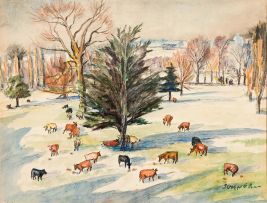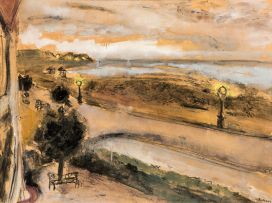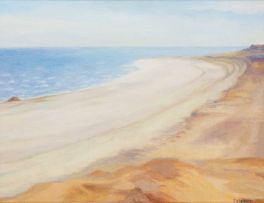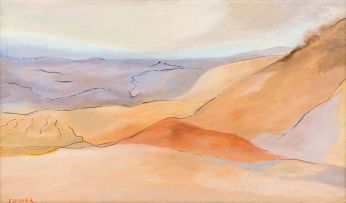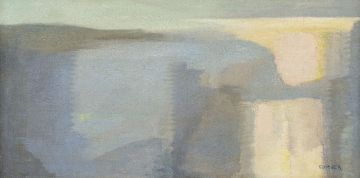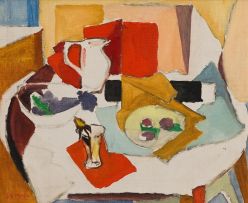Important South African and International Art
Live Auction, 7 November 2016
Evening Sale
Incl. Buyer's Premium & VAT
About this Item
signed; inscribed with the title, medium and date on a label adhered to the reverse
Notes
Evidence of a major shift in Maude Sumner's subject matter appears in the 1950s. Up to that point she had almost exclusively focussed on interiors and still-lifes. A devout Catholic, Sumner's spiritual concerns developed alongside her art, and she increasingly sought solace in the silence of the Namibian desert and the vast, outstretched planes of the Karoo. Yet in the present lot the stillness of the desert is spectacularly disturbed by a steam train powering through the landscape. Frieda Harmsen, writing about the painting, noted the Karoo's 'warm pastel colours, its endless vistas, and its peaked and flat-topped koppies. It is an accurate rendering of what anybody can in fact see. And yet it betrays Sumner's yearnings and preoccupations. A man-made machine is propelled by an unseen driver through what appears to be an uninhabited wasteland. With a great deal of noise humanity wants to travel through this space, and leave behind its promise of quietude which is implicit in the small dam with its attendant trees. Sumner has very decidedly opposed the contrasts of hurry and time, the restless and the peaceful, the materialistic and the idyllic. Not only does she formulate this statement with the depiction of man-made objects (the train, rails and cattle grid) intruding on God's creation which is here epitomised by land, trees, water and sky, but she emphasises her point with tone and colour. The right quarter of the painting where we see the train is darker, the colours stronger and the forms more crisply defined than in the rest of the picture. As a result the train ''reads'' as a noisy intruder. The curve of the rails, however, sweeps out of the format, and drags the train along with it. In this painting the train is crossing space, but because it cannot part from itself, it cannot enter the silence it traverses. Mysticism and a hankering for silence (which to a large extent is explicit in Steam Train in the Karoo) was to be Sumner's impetus for the rest of her career.'1
1 Frieda Harmsen. (1992) Maud Sumner: Painter and Poet. Pretoria: JL van Schaik publishers. Pages 121 and 122.
Literature
Elza Miles (ed.) (2005) A Journey Beyond the Immediate. Graham's Fine Art Gallery. Illustrated in colour, unpaginated.
Frieda Harmsen. (1992) Maud Sumner: Painter and Poet. Pretoria: JL van Schaik Publishers. Illustrated in black and white on page 122.


